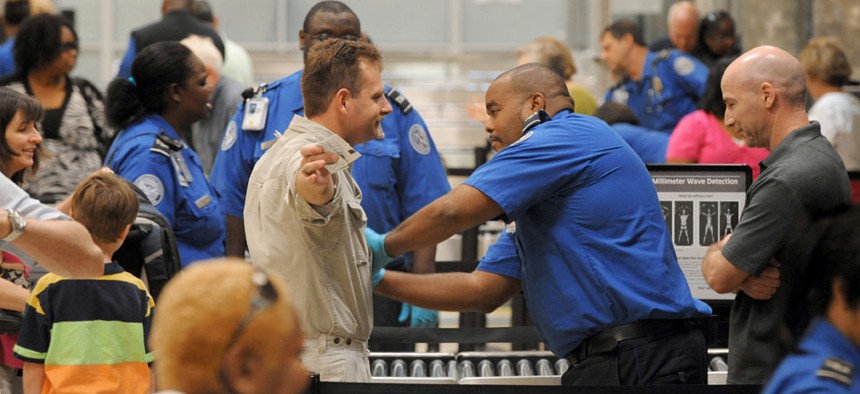Attention, Passengers: $15,000 Prize for Whoever Can Speed TSA Screening

Airline passengers go through the Transportation Security Administration security checkpoint at Hartsfield-Jackson Atlanta International Airport. Erik S. Lesser/AP File Photo
Agency launches online contest for citizens to design 5-minute wait line systems.
In anticipation that more fliers will be eager to pay for expedited checkpoint screening, the Transportation Security Administration has promised to award $15,000 in cash prizes to whoever can design a faster waiting line system.
TSA on Tuesday opened a competition on InnoCentive, a website for crowdsourcing solutions to problems, which enables individuals and teams to submit proposals.
"There is a guaranteed award," the contest overview states. "The total payout will be $15,000, with at least one award being no smaller than $5,000 and no award being smaller than $2,500."
The challenge aims to solve expected problems with TSA PreCheck, a program where passengers who undergo a background check and pay $85 get access to fast lanes that don't require removing shoes, coats, liquids and laptops.
"Current queue layouts at TSA Pre✓ airports will need to adapt to support the increasing population of TSA Pre✓ passengers," the overview states. "TSA is looking for the Next Generation Checkpoint Queue Design Model to apply a scientific and simulation modeling approach to meet queue design and configuration needs of the dynamic security screening environment with TSA Pre✓."
TSA also is asking for approaches that would help speed standard, “free” waiting lines.
Competitors must supply a proposal that considers physical logistics, peak hours and staffing schedules, among other constraints. Entrants have until Aug. 15 to submit a concept and evidence that it works. So far, about 70 problem solvers have registered.
The line, in this scenario, extends from the point where a passenger joins the end of the queue to the metal detector or body scan machine.
The rules for the challenge state wait times cannot be more than 5 minutes for PreCheck and 10 minutes for standard lines. Also, the model should enable TSA to apply a "Computer Aided Design drawing (e.g. DWG or DXF file format) to define the physical space available for queuing." Applicants, however, do not have to create the image files themselves.
Competitors are required to provide a 2-D animation of a computer screen that shows passengers flowing through lines. It must display "real-time reporting during the animation, and allow [a] user to pause a simulation run when necessary for analysis or evaluation,” according to the rules.
TSA employees are not allowed to play.
The contest is advertised on a federal website for vendors seeking government contracts. In fact, a similar contract solicitation invites companies to bid on a research project that focuses on improving passenger screening, among other TSA operations. Contracts awarded under the project last year ranged from about $480,000 to $5 million.
TSA officials Friday told Nextgov the prize competition is underway to tap unconventional minds, whereas the research solicitation is geared toward veteran contractors.
The contract “is a formal acquisitions vehicle that agencies use to invite the latest thinking on broadly defined areas of interest, usually eliciting engagement from mostly well-established, traditional industry players,” TSA spokeswoman Bessy Guevara said in an email.
The challenge “is about leveraging innovation and out-of-the-box thinking to find solutions to TSA’s most challenging issues – in our instance, for more effective and dynamic queue design,” she added. It “is a targeted request for inventive ideas that allows us to do crowd sourcing by engaging a diverse and nontraditional group of thinkers and solvers.”
Under the terms of the online contest, TSA will not own intellectual property rights to the ideas suggested. TSA, however, will get "a royalty-free, perpetual and non-exclusive license to use any information included in this proposal,” the agreement states.






